ALL-IN-ONE PLATFORM
esDynamic
Manage your attack workflows in a powerful and collaborative platform.
Expertise Modules
Executable catalog of attacks and techniques.
Infrastructure
Integrate your lab equipment and remotely manage your bench.
Lab equipments
Upgrade your lab with the latest hardware technologies.
PHYSICAL ATTACKS
Side Channel Attacks
Evaluate cryptography algorithms from data acquitition to result visualisation.
Fault Injection Attacks
Laser, Electromagnetic or Glitch to exploit a physical disruption.
Photoemission Analysis
Detect photon emissions from your IC to observe its behavior during operation.
EXPERTISE SERVICES
Evaluation Lab
Our team is ready to provide expert analysis of your hardware.
Starter Kits
Build know-how via built-in use cases developed on modern chips.
Cybersecurity Training
Grow expertise with hands-on training modules guided by a coach.
ALL-IN-ONE PLATFORM
esReverse
Static, dynamic and stress testing in a powerful and collaborative platform.
Extension: Intel x86, x64
Dynamic analyses for x86/x64 binaries with dedicated emulation frameworks.
Extension: ARM 32, 64
Dynamic analyses for ARM binaries with dedicated emulation frameworks.
DIFFERENT USAGES
Penetration Testing
Identify and exploit system vulnerabilities in a single platform.
Vulnerability Research
Uncover and address security gaps faster and more efficiently.
Code Audit & Verification
Effectively detect and neutralise harmful software.
Digital Forensics
Collaboratively analyse data to ensure thorough investigation.
EXPERTISE SERVICES
Software Assessment
Our team is ready to provide expert analysis of your binary code.
Cybersecurity training
Grow expertise with hands-on training modules guided by a coach.
INDUSTRIES
Semiconductor
Automotive
Security Lab
Gov. Agencies
Academics
Defense
Healthcare
Energy
ABOUT US
Why eShard?
Our team
Careers
FOLLOW US
Linkedin
Twitter
Youtube
Gitlab
Github
D810: A journey into control flow unflattening
Summary
Last year we released D-810, our IDA-Pro plugin that we used to analyze obfuscated binaries. In last blog post, we focused on how D-810 can be used to remove the instruction level obfuscation. This time, we wanted to explain how D-810 can be used to deal with control flow flattening.
We start by giving a quick overview of what is control flow flattening and how it can be removed. Then, we describe the components of D-810 which can be used to remove this type of obfuscation:
- Backward variable tracking
- Microcode emulation
- Microcode control flow patching
Finally, we demonstrate how D-810 can be used and configured to remove the control flow flattening generated by Tigress obfuscator.
The code of D-810 can be found here and the samples used in this blog post can be found here.
What is Control Flow Flattening?
The goal of flattening is to hide the original control flow of a function by putting all the function basic blocks on the same level. For instance, before this obfuscation pass, the graph of a function can look like that:

Depending on the obfuscator used (and its configuration), the graph of the obfuscated function can look like the following ones:
- Obfuscation with OLLVM control flow flattening (and bogus control flow)
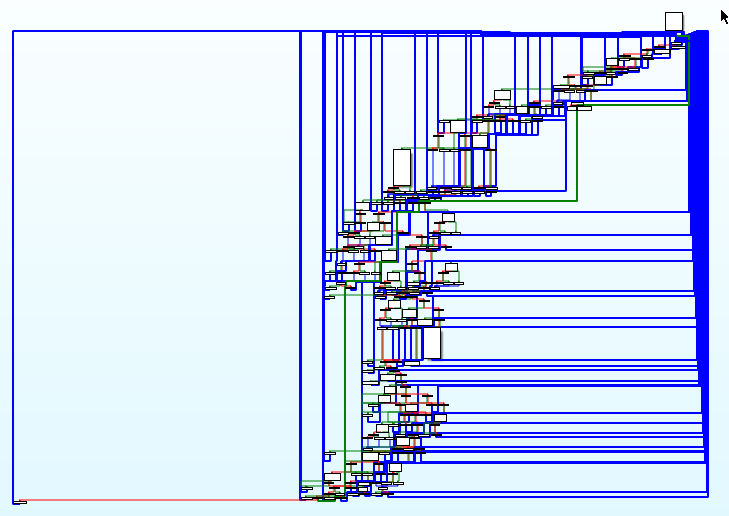
- Obfuscation with Tigress Flatten with switch dispatcher method

- Obfuscation with Tigress Flatten with indirect dispatcher method

In practice, this obfuscation technique is quite annoying as it prevents us from quickly understanding a function. For example, here is an extract of the decompiled code of the function obfuscated with Tigress Flatten (using the switch dispatcher method):
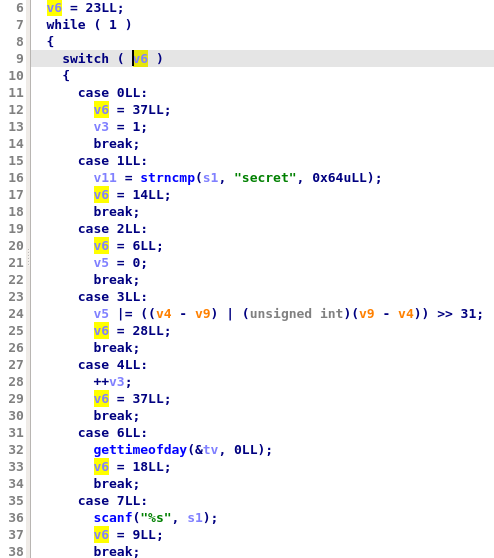
Here are a few things that will slow down the analysis of this function:
- It is not straightforward to find in which order the blocks are executed. For instance, is gettimeofday called before or after strncmp ?
- It is hard to identify the structure of the function (e.g. its loops)
- It can lead to decompilation warnings. For instance, at line 24, we can see that variables v4 and v9 are in orange because IDA Pro has identified that these may be undefined.
How to remove control flow flattening?
Even if the graph of the function obfuscated with the three control flow flattening techniques described before look very differents, they all share several common elements:
- A state variable is used to keep track of which block of code should be executed
- A dispatcher which uses the state variable to find which block to execute next
- Each block of the original function is modified: instead of specifying the next blocks to execute using a branch, it updates the state variable and jumps to the dispatcher
However, depending on which obfuscator you are using, the way these elements are used will change:
- For OLLVM, the state variable is a 32 bit constant with high entropy (this was used as an heuristic by Rolf Rolles to identify flattened functions). The dispatcher consists of multiple jumps that compares this state variable to other 32 bits constants.
- For Tigress Flatten with switch dispatcher, the dispatcher is a switch statement where each case is a block of the original function. This switch statement is wrapped inside an infinite loop so that each block will update the state variable to specify which case of the switch statement should be executed next.
- For Tigress Flatten with indirect dispatcher, the address of each of the function basic block is stored in a global jump table. The state variable is the index of the next block to execute in this jump table. Each block will update the state variable, lookup the address of the next block in the jump table and jump to the dispatcher which is an indirect jump to the original function block.
Removing control flow flattening is not a new topic and there are several very well written blog post which explains in great details how it can be done:
- A Quarkslab's blog post explains how OLLVM control flow flattening can be removed using Miasm2 and symbolic execution
- A Rolf Rolles blog post explains how he was able to remove OLLVM control flow flattening obfuscation in his HexRaysDeob IDA Pro plugin
To summarize, the strategy to unflatten a function is relatively simple:
- First, we have to identify the dispatcher blocks and the state variable
- Then, for each block which jumps to the dispatcher entry block, we have to:
- Find the value of the state variable at the end of this block
- Find the address of the next block to execute based on the dispatcher and the value of the state variable
- Replace the jump to the dispatcher by a jump to the next block
However, life is not that simple and multiple problems can happen:
- Finding the value of the state variable may not be easy: it can be computed using constant obfuscation or opaque predicate
- => We need to be able to compute it dynamically
- The dispatcher blocks may have a side effect and therefore they can't be totally removed
- => We need to have a way to detect these instructions and copy them when we replace the jump to the dispatcher by a jump to the next block
- Multiple dispatchers can be used inside one function (e.g. VMware Carbon Black blog post)
How does D-810 deal with control flow flattening ?
Initially, we tried to develop a generic rule which could deal with all control flow flattening techniques, but we failed :). However, we identified several features that we were using almost all the time:
- Backward variables tracking: We need to have a way to find which microcode instructions are used to compute specific variables.
- Microcode emulation: We need to be able to execute Hex-Rays microcode. We will use it to compute the value of the variables searched with backward variable tracking.
- Hex-Rays microcode control flow patching: We need to change the successors and predecessors of microcode blocks in order to remove the control flow flattening.
Before explaining these techniques, let's have a quick look at the relevant parts of the Hex-Rays microcode API.
Hex-Rays Microcode API
Hex-Rays published its microcode API several years ago and at the same time, they allowed us to hook the decompilation process. Thanks to this API, we can remove several obfuscation layers during decompilation.
More precisely, there are two type of callbacks that we can use:
optinsn_tis mostly used to perform optimization at the instruction layer. This is what we demonstrated in our previous blog postoptblock_tcan be used to analyze and modify function blocks. This is what we are using to remove control flow flattening.
When we are optimizing microcode instructions, we are dealing with the following 2 data structures:
minsn_t: a microcode instruction which contains (up to) three operandsmop_t: an operand used in a microcode instruction. It can be a number, a register, a stack variable or even a microcode instruction
When we are optimizing the control flow of a function, we are also using 2 other data structures:
mblock_t: a basic block of a functionmba_t: a structure which contains all blocks of a function
In each mblock_t, we can find information about:
- The list of microcode instruction in this basic block
- The list of predecessors and successors of this basic block
- The block number in the
mba_t, referred to as block serial - Data that must/may be used/defined by the block
This information can be visualized using tools such as lucid:
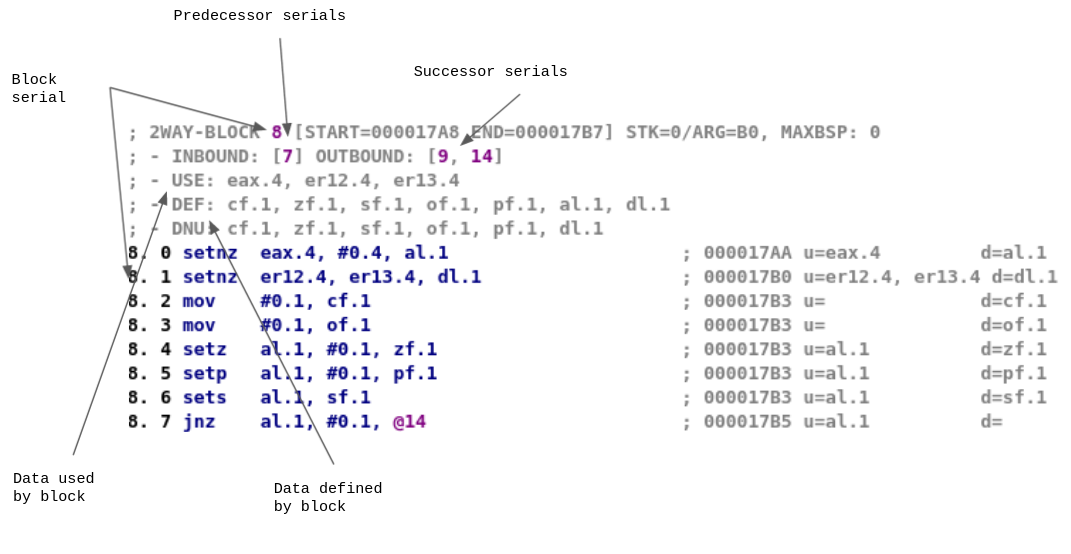
So, in order to remove the control flow flattening of a function, D-810 will register an optblock_t callback and inspect and modify mblock_t blocks.
MopTracker: Backward variables tracking
In order to unflatten a function, we have to recover the value of the state variable at the end of each block. Our strategy for this part was to locate the instructions which are involved in the computation of this state variable.
Fortunately, Hex-Rays microcode API can be used to determine if an instruction is used to compute a variable. Thus, we can use this API and walk backwards through a block (and its predecessors) to find the instructions used to define the variable.
For instance, here is the entry block of the dispatcher:

- We can see that the
eax.4register is used as a state variable - For some predecessor blocks of the dispatcher, it is straightforward to find the value of the state variable:

- However, it is not always that simple:
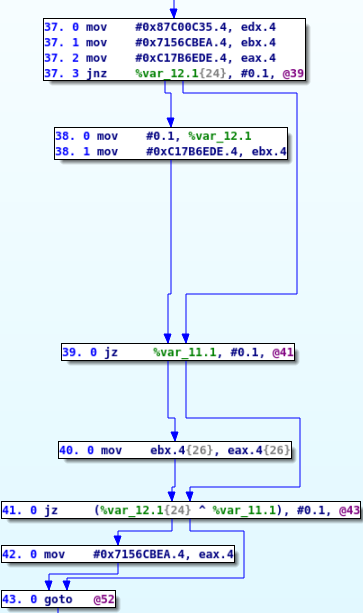
To deal with such cases, we have to be able to recursively search for the definition of other variables.
In the previous example case, our algorithm will start from block 43 and try to find the possible values of eax.4. Since there is no instruction used to compute eax.4 in block 43, we will search in its predecessors (blocks 42 and 41)
- In block 42, we can see that the
eax.4value is set to 0x7156CBEA, thus we can stop - In block 41,
eax.4is not specified thus we have to look into its predecessor (block 40 and 39)- In block 40, we can see that
eax.4is set toebx.4, thus we need to continue searching for the definition ofebx.4instead ofeax.4 - In block 39, we have no new information on
eax.4and must continue our search in its predecessors.
- In block 40, we can see that
In the end, our algorithm will output the 5 possible ways the eax.4 variable can be computed:
-
-> 42. 0 mov #0x7156CBEA.4, eax.4 -> 43. -
-> 38. 1 mov #0xC17B6EDE.4, ebx.4 -> 39. -> 40. 0 mov ebx.4, eax.4 -> 41. -> 43. -
-> 37. 1 mov #0x7156CBEA.4, ebx.4 -> 39. -> 40. 0 mov ebx.4, eax.4 -> 41. -> 43. -
-> 37. 2 mov #0xC17B6EDE.4, eax.4 -> 38. -> 39. -> 41. -> 43. -
-> 37. 2 mov #0xC17B6EDE.4, eax.4 -> 39. -> 41. -> 43.
Our implementation of this algorithm can be found in our MopTracker class and it was initially based on the code of Rolf Rolles. However we wanted to be able to deal with more complex cases:
- We wanted to support any type of operand (for instance to deal with state variable which is computed using constant obfuscation)
- We wanted to support memory assignment (from stack or from data segment of the binary)
The first part was relatively easy to do as we just had to perform backward tracking on a list of variables.
When we encounter a microcode instruction which defines the variable(s) we are looking for, we just have to update the list and continue the search.
For instance, if we are tracking the variables [eax.4] and we face the microcode instruction add ebx.4, ecx.4, eax.4, then we will remove eax.4 from the list of variables and add ebx.4 and ecx.4 to it. Hence, we will continue the backward variable tracking on [ebx.4, ecx.4].
Note that actual computation of the state variable is performed by the microcode interpreter of D-810 that we describe in the next section.
Dealing with memory assignment is another beast. Due to memory aliasing, a lot of things can go wrong. Thus, we only have partial support for this type of microcode operation and we give an example of that in the practical showcase on Tigress unflattening.
Microcode emulation
Using our MopTracker class, we are able to find the instructions used to compute the state variable at the end of a block. In order to compute its value, we created a Microcode emulator which allows us to evaluate any microcode instruction.
This component is split into two classes:
- A MicroCodeEnvironment class which is used to store information on the state of the program:
- It stores the value of registers and stack variables
- It stores the control flow information (current block and instruction to execute)
- A MicroCodeInterpreter which can be used to execute microcode instruction
- It will use the information stored in the MicroCodeEnvironment to compute the instruction
- It will update the values of variables stored in the MicroCodeEnvironment and the control flow information
Using it, we can execute the instructions found by our MopTracker to compute the value of the state variable for any path used.
We also use this microcode interpreter to emulate the dispatcher and to find out what was the serial of the next block to execute:
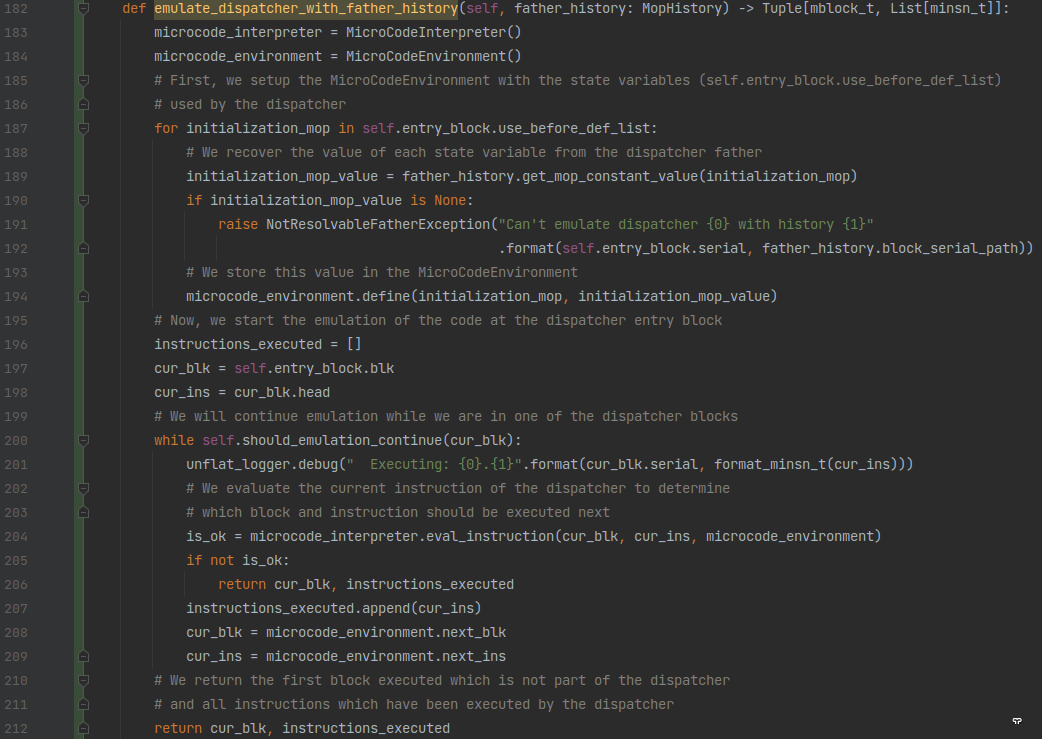
Microcode control flow patching
Once all this analysis is done, we must patch the microcode to remove the control flow flattening.
If the state variable at the end of a block that has only one possible value, we can easily recover the serial of the next block to execute by emulating the dispatcher as demonstrated in the previous section.
Then, we just have to replace the jump to the dispatcher by a jump to the unflattened block.
However, when a block has multiple possible values for the state variable it can become quite complex.
For instance, let's go back to the previous example where the state variable is eax and the dispatcher entry block is the block with serial 52:
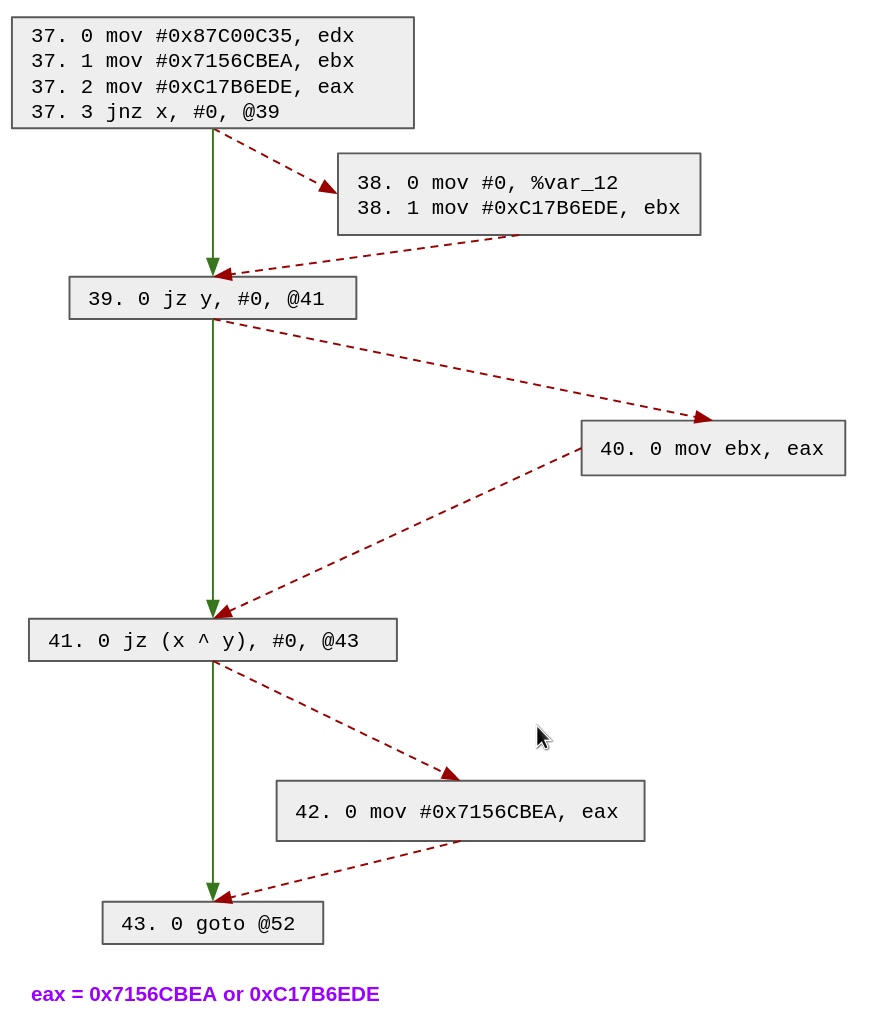
To deal with such cases, we duplicate several blocks of the function to ensure we are back in the simple case (i.e. with only one possible value for the state variable).
We use the output of our MopTracker to find out which block we should duplicate. The main idea of our algorithm is to duplicate any block which appears in (at least) 2 paths with (at least) 2 different predecessors. By doing that recursively, we will ensure that all blocks that jump to the dispatcher will have only one possible value for the state variable.
This is performed by the duplicate_histories function.
Let's see how it works in this example. As a reminder, we already shown how D-810 MopTracker was able to find the 5 possible paths which can define eax:
42 -> 43 38 -> 39 -> 40 -> 41 -> 43 37 -> 39 -> 40 -> 41 -> 43 37 -> 38 -> 39 -> 41 -> 43 37 -> 39 -> 41 -> 43
We look for a block which appears in (at least) 2 paths with (at least) 2 different predecessors:
- 39 appears 4 times and has 2 different predecessors (37 and 38)
- 41 appears 4 times and has 2 different predecessors (39 and 40)
- 43 appears 5 times and has 2 different predecessors (42 and 43)
We can choose any of these blocks, so let's choose block 39. Note that because the block 39 ends with a conditional block we must create 2 blocks:
- The block 60 which is a copy of the block 39
- The block 61 which is the default case of the block 60 and which will jump to the original default case of the copied block Additionally, we modify the block 38 to make it jump to the duplicated block:

We can update the possible paths with this patch and search for the next block to duplicate:
42 -> 43 38 -> 60 -> 61 -> 40 -> 41 -> 43 37 -> 39 -> 40 -> 41 -> 43 37 -> 38 -> 60 -> 41 -> 43 37 -> 39 -> 41 -> 43
Based on the updated possible paths, we will duplicate block 40 (we also could have chosen block 41 or 43). Note that since it is a one way block, we only need to create 1 block (70):
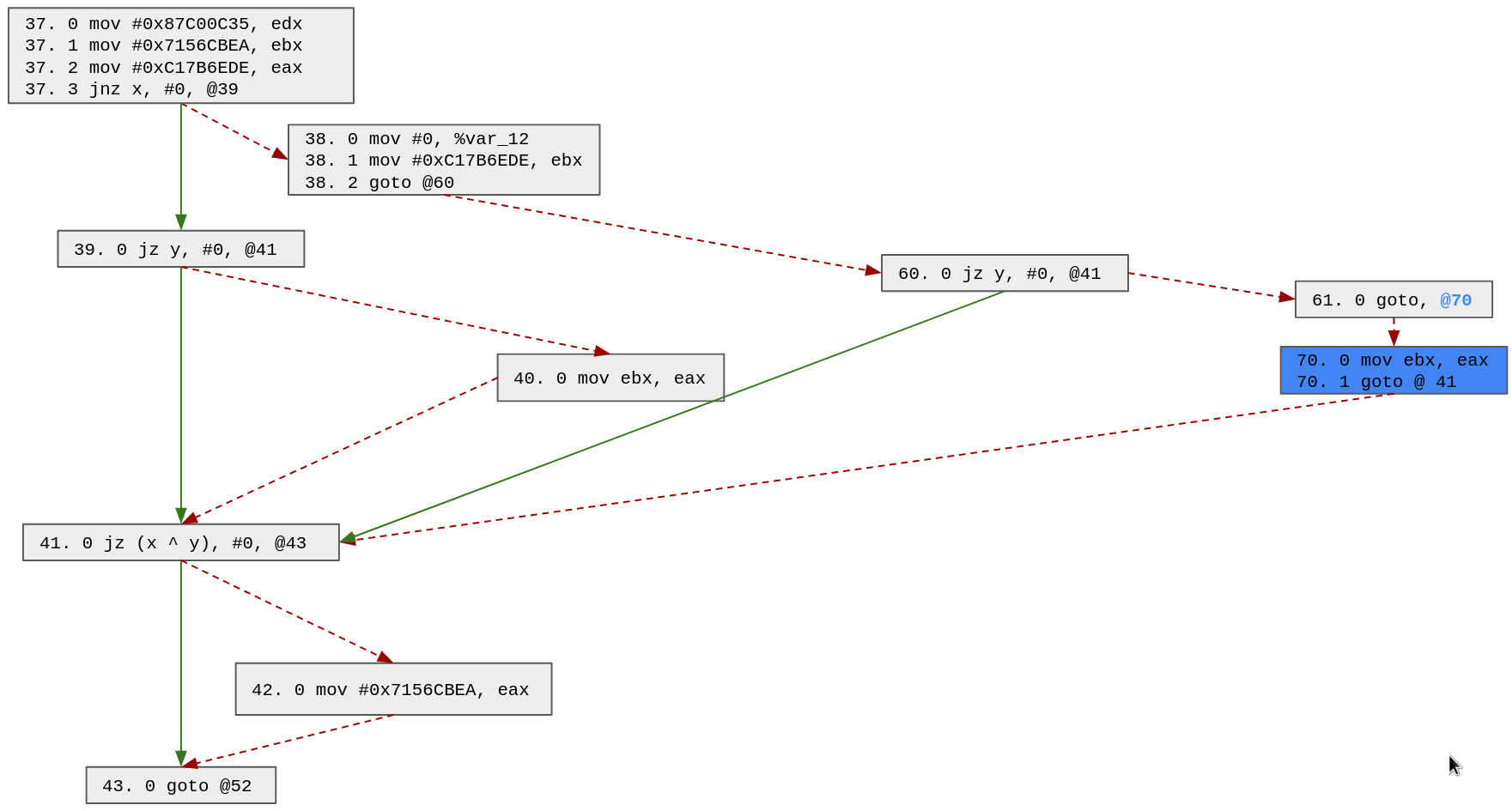
We can update the possible paths with this patch and search for the next block to duplicate:
42 -> 43 38 -> 60 -> 61 -> 70 -> 41 -> 43 37 -> 39 -> 40 -> 41 -> 43 37 -> 38 -> 60 -> 41 -> 43 37 -> 39 -> 41 -> 43
Based on the updated possible paths, we will duplicate block 41 (we also could have chosen block 43). Note that the block 41 has 4 possible predecessors (70, 40, 60 and 39), thus we need to clone it 3 times:
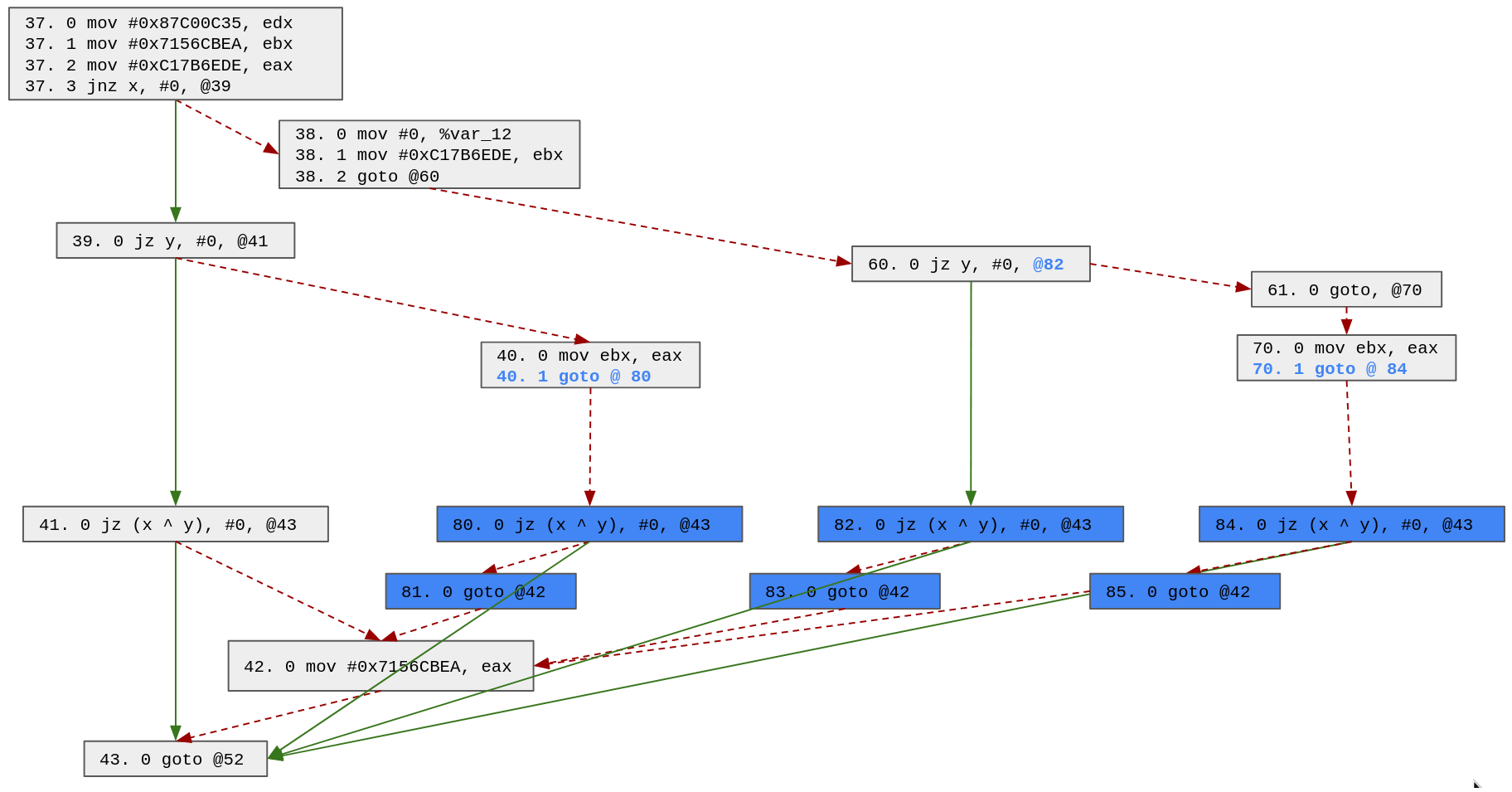
At this point in time, the possible paths look like this:
42 -> 43 38 -> 60 -> 61 -> 70 -> 84 -> 43 37 -> 39 -> 40 -> 80 -> 43 37 -> 38 -> 60 -> 82 -> 43 37 -> 39 -> 41 -> 43
The only remaining block to duplicate is the block 43. Indeed, even if block 42 has multiple predecessors, it appears only once in the possible paths, thus we do not need to duplicate it.
In the end, we end up with the following control flow:
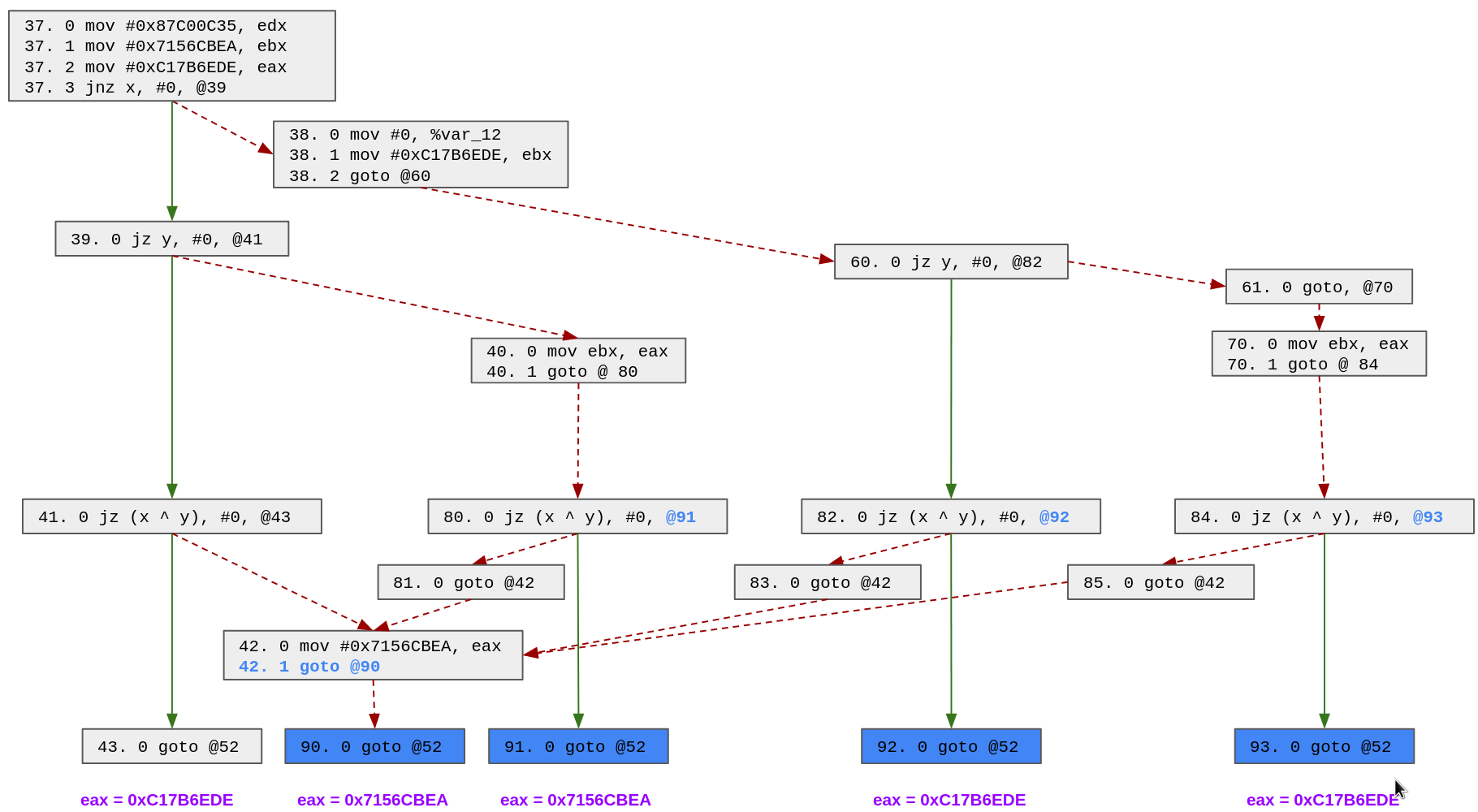
Now, we are back in the simple case, at the end of each block (43, 90, 91, 92 and 93), the state variable has only one possible value and we can patch it easily.
The main advantage of this approach is that it is generic and can be used to transform the graph of the function into something that we can simplify. However, one downside is that we may end up duplicating a lot of code in some weird cases.
Putting all together to remove control flow flattening
Using these three features of D-810, we were able to remove most of the control flow flattening techniques we encountered.
Most of the code unflattening currently implemented in D-810 relies on the GenericDispatcherUnflatteningRule rule and the process is the following:
-
The rule explores all functions' blocks and tries to find all dispatchers and the state variables
-
This is the only part which is specific to the obfuscation techniques that we try to remove because we need to specify the shape of the dispatcher and state variables.
-
If no dispatcher is found, we stop there
-
- For each dispatcher, we will fix each block which jumps to the dispatcher entry point:
-
We use our MopTracker to check if the block can be fixed (i.e. there is only 1 possible value for the state variables at the end of the block).
-
If there are multiple possible values, we use the microcode control flow patching strategy discussed in the previous section.
-
If we didn't find how the state variables are computed, we won't fix this block
-
-
We emulate the dispatcher code using the value of the state variables in order to identify what is the next block executed (i.e. the first block executed which is not part of the dispatcher)
-
We replace the jump to the dispatcher by a jump to the next block.
-
- If we made any modification to the control flow of the function, we ensure that the rule is called again. By doing so, we give ourselves a new chance to fix the blocks that couldn't be fixed in the first pass because we were not able to find how the state variables was computed.
While we were able to remove most of the code flattening techniques that we encounter up until now, we believe that there is quite a room for improvement in the current solution:
- By default, D-810 considers that all functions are flattened and thus this analysis will always be performed. Since it can have a considerable impact in decompilation time, the analyst can configure the rule using either a whitelist or blacklist to specify which functions should be unflattened.
- In the future, we would like to be able to automatically detect if a function is flattened for instance using the work from Tim Blazytko
- Relying on backward variables tracking has several limitations. For instance, if the state variable is stored/read to/from memory, there may be side effects that we won't be able to detect (e.g. because of aliasing). This may result in incorrect or impossible simplification.
- Implementing a symbolic execution engine over microcode could help us design a much cleaner solution
Practical case: Deobfuscating Tigress Flatten with indirect jumps dispatcher
For O-LLVM flattening, no configuration is needed and D-810 should be able to simplify the code directly. However, for other obfuscators, it is not always straightforward. So, we decided to showcase how we can configure D-810 to help it deobfuscate the code generated using Tigress Flatten transformation with:
-
Randomized blocks => the basic block sequence is randomized
-
Split basic blocks => the initial basic blocks are split in multiple basic blocks
-
Dispatcher of type indirect => indirect gotos through a jump table are used to switch between blocks
We also decided to use the Tigress Encode Arithmetic transformation to add complexity to the original function and make things a bit more interesting.
For the function to obfuscate we generated a function using Tigress Random Function feature and we modified it a bit to add constant obfuscation. The original source code of the function (and its obfuscated version) can be found here. The binary used in this example can be found here.
Let's see how it looks when we reverse engineer the function protected with this technique.
Initial observations and fixes
When we open the protected binary in IDA Pro, we can quickly see that the function is not correctly identified:
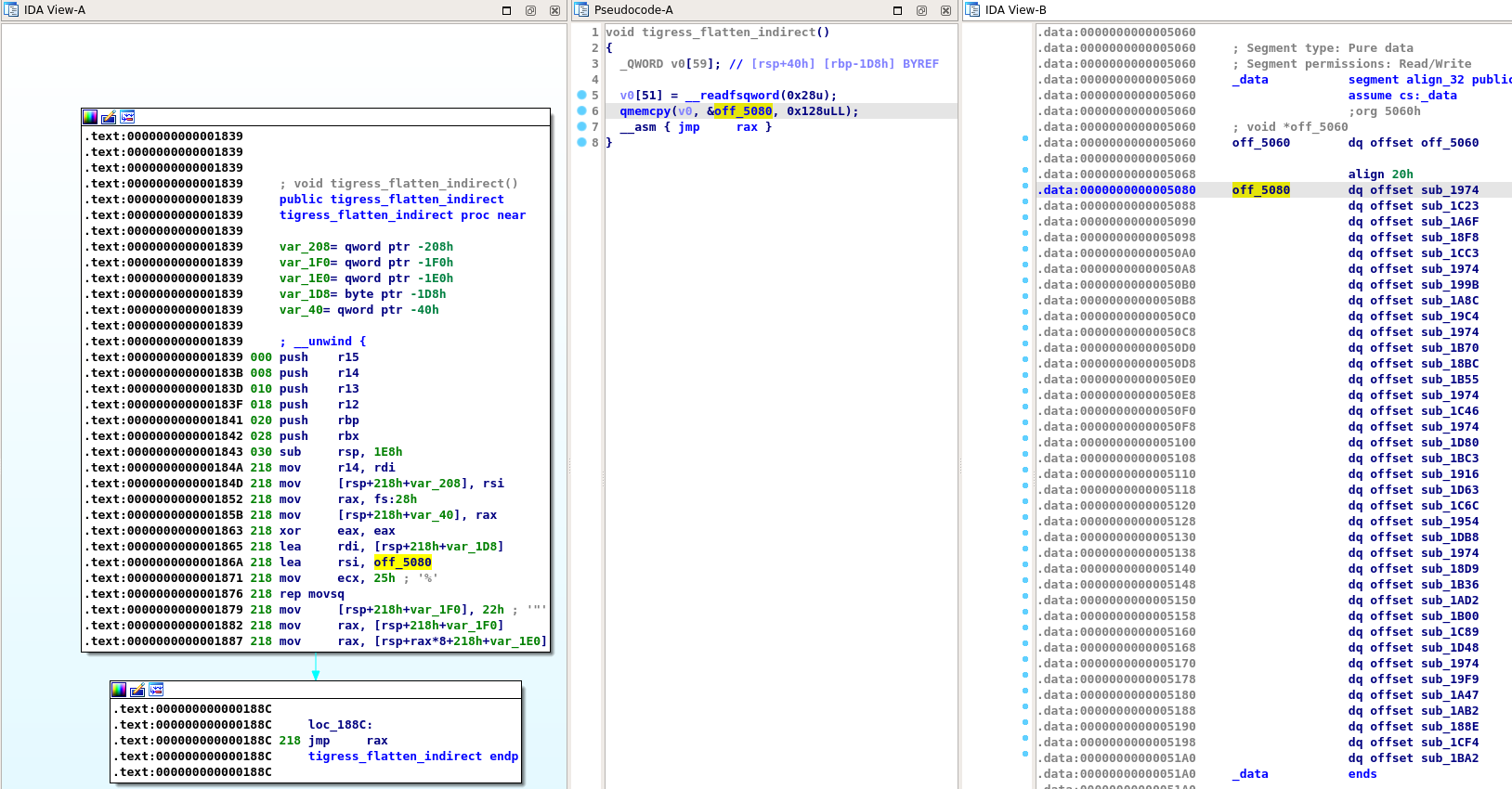
We noticed that IDA Pro initial analysis created a function for each of the basic blocks of the original function and their addresses are stored at address 0x5080 (in a RW segment).
Additionally, because of the jmp rax instruction at address 0x188c, IDA Pro can't find the next block to execute and considers this is the end of the function. Note that this is expected and we can't blame IDA for that:
-
The table at address 0x5080 is in a writable segment, so IDA Pro can't assume that this table is not modified when the tigress_flatten_indirect function is called.
-
The table is copied in a stack variable (line 6 of decompiled code)
So, the first thing we need to do is to delete the incorrect functions and fix the tigress_flatten_indirect function bounds.
It can be done with the following script:
from idaapi import get_qword, del_func, add_func flattened_function_info = { "start_ea": 0x1839, "end_ea": 0x1DDD, "jump_table_ea": 0x5080, "jump_table_nb_elt": 37 } # IDA creates function for each jump table entry => we need to remove them for i in range(flattened_function_info["jump_table_nb_elt"]): label_ea = get_qword(flattened_function_info["jump_table_ea"] + 8 * i) del_func(label_ea) # If we create the function manually, its end won't be correct, so we explicitly specify its end del_func(flattened_function_info["start_ea"]) add_func(flattened_function_info["start_ea"], flattened_function_info["end_ea"] + 1)
Now, the function bounds are correct but we are facing a new issue that will prevent us from removing the control flow flattening:
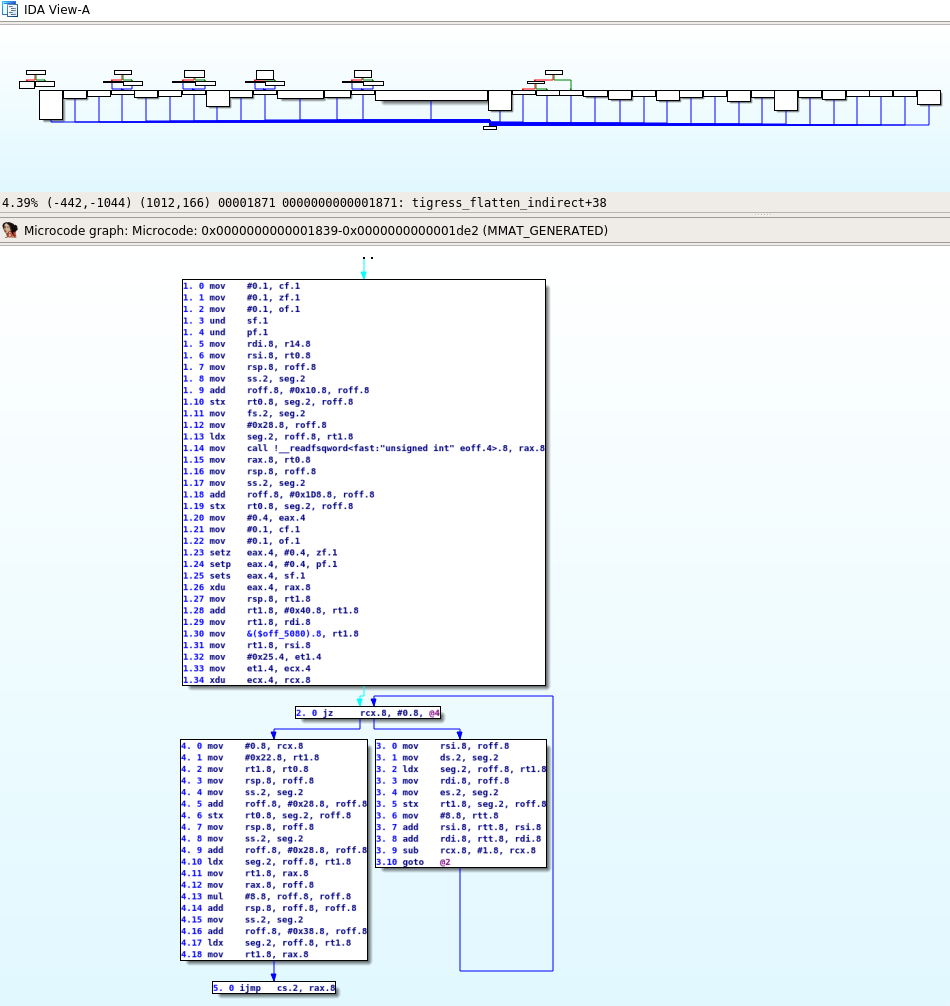
During the decompilation process, the Hex-Rays microcode evolves and these levels of evolution are called maturity. In the previous image, we show the microcode generated in the lowest maturity (MMAT_GENERATED). The issue that we can observe is that this microcode only includes the basic blocks before the jmp rax instruction. We believe that this is because IDA Pro does not see a path between the other blocks and the entry point of the function and thus considers them as dead code and does not bother decompiling them.
Therefore, we must trick IDA into decompiling them and we will do that by adding cross reference between the jmp rax instruction and all the other blocks of the jump table. We can do that using the following script which will create cross references between the dispatcher and all flattened blocks:
from idaapi import get_qword, add_cref, fl_JN flattened_function_info = { "start_ea": 0x1839, "end_ea": 0x1DDD, "jump_table_ea": 0x5080, "jump_table_nb_elt": 37, "jump_rax_ea": 0x188C } for i in range(flattened_function_info["jump_table_nb_elt"]): label_ea = get_qword(flattened_function_info["jump_table_ea"] + 8 * i) x = add_cref(flattened_function_info["jump_rax_ea"], int(label_ea), fl_JN) print(x) print("Adding cref from {0:x} to {1:x}".format(flattened_function_info["jump_rax_ea"], label_ea))
Now that we created those "fake" cross references, all blocks will be decompiled by IDA Pro and we can start our work.
Note that at the end of maturity MMAT_LOCOPT, IDA Pro will see that these blocks are not reachable and will remove them. Thus, D-810 rule needs to be applied at maturity MMAT_LOCOPT.
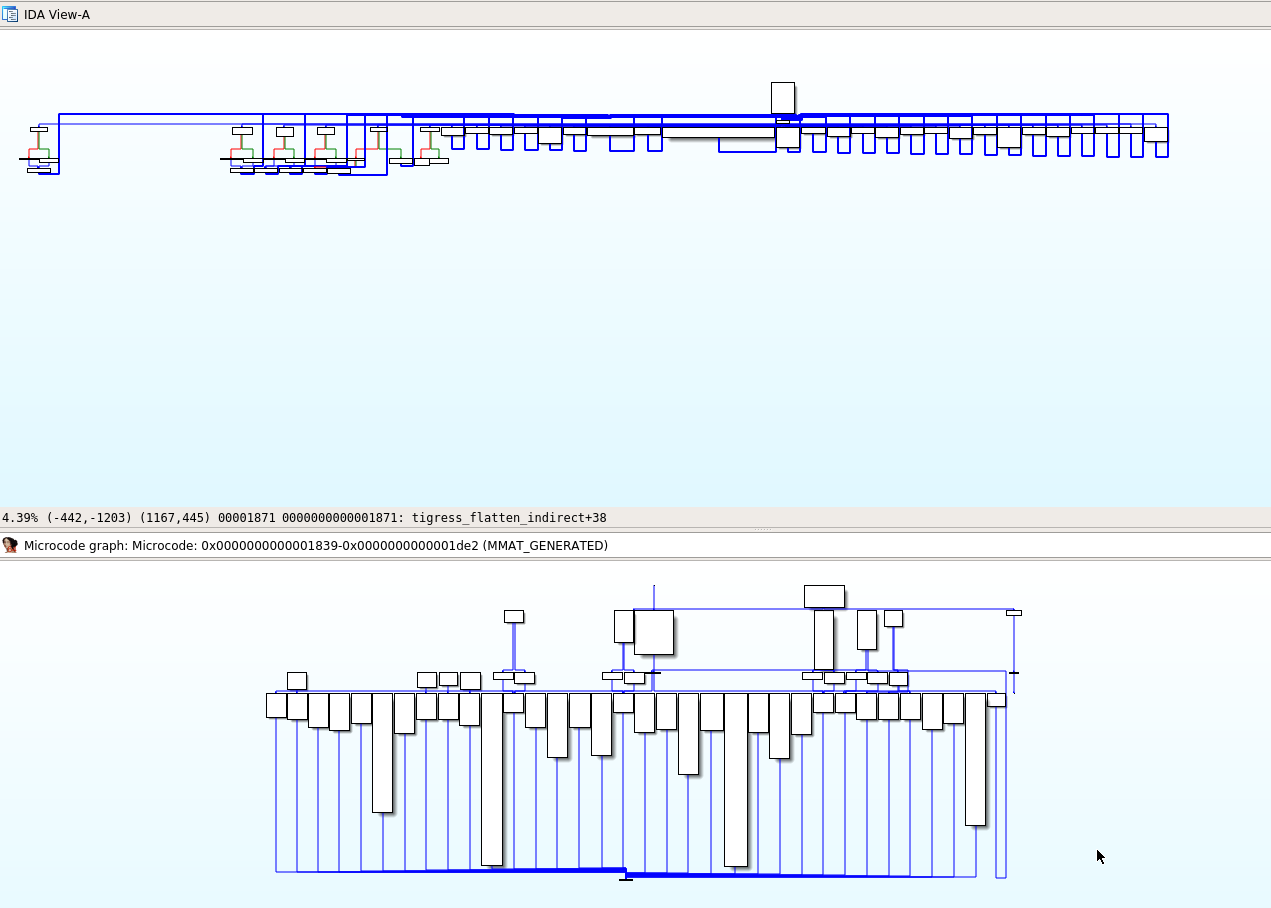
Configuring D-810 to remove control flow flattening
D-810 includes a rule UnflattenerTigressIndirect which deals with this technique of control flow flattening. However, we need to configure it in order to work properly.
As explained before, the jump table used by the dispatcher is copied into a stack variable at the beginning of the function, which translates to the following microcode (at maturity MMAT_LOCOPT):

- At line 1.10,
rdiis set torsp + 0x40 - At line 1.11,
rsiis set to&($off_5080)(the jump table stored in the .data section) - At line 1.12,
rcxis set to 0x25 (the number of element of the jump table) - Block 2 and 3 are used to copy this table to
rsp + 0x40
Then, at the end of each block the address of the next block is recovered using a pattern similar to this one:

At maturity MMAT_LOCOPT, IDA Pro will already have performed some optimization and the microcode will look like that:

In order to find the value of the state variable (rax) at the end of the block 26, D-810 will use its MopTracker, which will fail because there is no direct assignment of stack variable %0xD8.8.
This is linked to the fact that this value is accessed indirectly in the initial loop (blocks 1, 2 and 3).
Currently D-810 is not able to identify that automatically. However, we can tell it what the initial value of the stack is when this function is called.
In order to configure the UnflattenerTigressIndirect rule, we need to specify:
-
The address of the function flattened (-> 0x1839)
-
Information regarding the goto table of this function:
-
Its address in the .data section (-> 0x5080)
-
Its number of elements (-> 37)
-
The stack offset where it will be stored (-> 0x40)
-
This can be done by editing the rule configuration file of D-810:
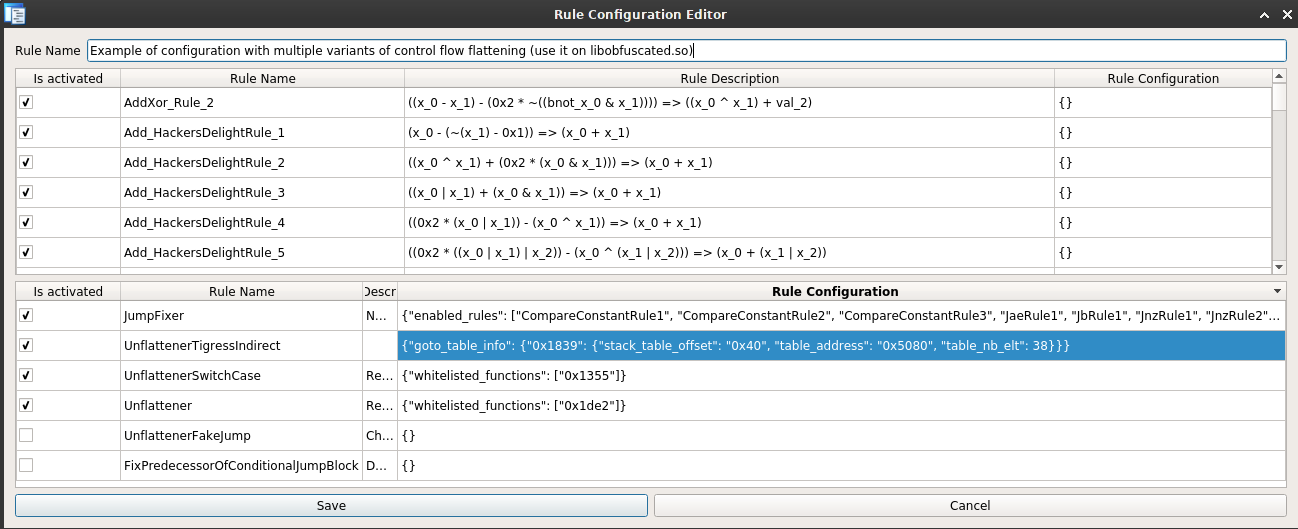
In practice, the rule will use this information to create a mop (microinstruction operand) located at the appropriate stack offset and tell the MopTracker that this mop is equal to the data stored in the table stored in the RW segment.
Once this is done, D-810 will be able to remove the control flow flattening protection and we will have a much cleaner function:
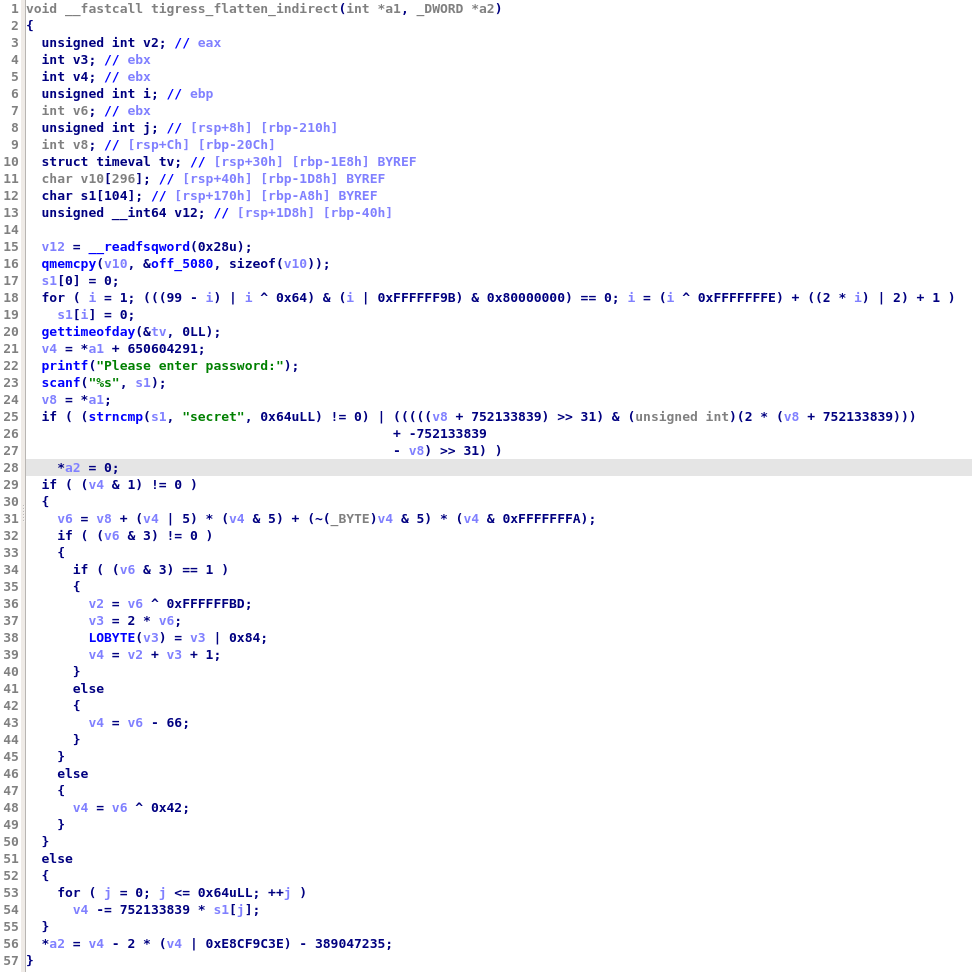
Conclusion
In this blog post, we described some of the techniques used by D-810 to remove control flow obfuscation. As explained in this blog post, we do not have a generic method that will allow us to remove all possible control flow flattening techniques without any manual work.
However, D-810 implements several features which can be used to quickly develop new rules when we are facing a new obfuscation technique.
We are still investigating new techniques such as symbolic execution that could allow us to achieve better results.
Some final disclaimers:
-
Patching control flow incorrectly during decompilation is likely to make IDA crash. Even though we are trying hard to do things properly, we can't make any promises. Thus, make regular snapshot of your database when using D-810.
-
For those wondering if Tigress is broken by D-810, the answer is clearly NO. We demonstrated how D-810 can be used to remove one configuration of the Tigress Flatten transformation. Tigress has a huge number of transformations, some of them are out of reach of D-810 by design (e.g. virtualize, jit) while some others can be harder to simplify depending on how they are configured.
Acknowledgments
Rolf Rolles for his HexRaysDeob plugin and his blog post. The current code of our plugin uses ideas (and code) from his work.
Dennis Elser for his genmc plugin and Markus Gaasedelen for lucid which helped us analyze microcode at various maturity levels.
Tigress C obfuscator and O-LLVM for providing awesome free obfuscators and allowed us to try D-810 on multiple obfuscation techniques.
Thanks to Tiana and Yorick for their review of this blog post and our discussion around D-810!
References
- https://gitlab.com/eshard/d810
- https://www.hex-rays.com/blog/hex-rays-microcode-api-vs-obfuscating-compiler/
- https://github.com/RolfRolles/HexRaysDeob
- https://blog.quarkslab.com/deobfuscation-recovering-an-ollvm-protected-program.html
- https://github.com/patois/genmc
- https://github.com/gaasedelen/lucid
- https://tigress.wtf/
- https://github.com/obfuscator-llvm/obfuscator